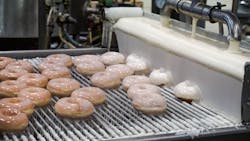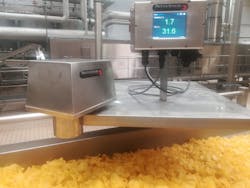Controlling food production costs made simple with NIR analysis
As the global food market becomes more specialized and competitive, processors are feeling the pressure to innovate while meeting the high expectations set by their consumers. However, with inflation impacting the food industry hard today, these pressures are compounded.
From flour to seasoning sprays, food ingredients have always been among the highest routine expenses for any food processor. These ingredients are generally sold to food processors based on the availability of specific quality parameters like moisture, fat/oil content, protein and crude fiber, to name a few. In most cases, food processors take their suppliers at their word regarding the quality of their ingredients.
Once in production, however, they may find that their ingredients may affect the processing of the food product, and potentially yield a poor-quality final product.
Then, for various reasons, ingredient properties can change during the food production process. Routine at-line or in-process product quality analysis is also necessary to maintain high standards and avoid over-formulating (or over-using) costly ingredients.
Few options to control essential parameters
One option is to submit ingredient or product samples to external quality laboratories for analysis. Over time, this can become quite costly; sample analysis typically costs an operation between $20-50 per sample. Also, it can take days to receive results, which means the ingredients or food products could have been used in production and distributed to consumers.
As an alternative, more food processors are investing in near-infrared (NIR) technologies to help fortify their quality assurance protocols. In this process, the instrument transmits near-infrared light onto a product sample, which absorbs at various wavelengths. A detector on the device reads the reflected NIR light. Then, using a calibration, the instrument generates data on a specific quality parameter (moisture, fat, protein, etc.). Most NIR instruments will provide comprehensive data in under 30 seconds and in-process instruments can transmit data in real time.
Customized calibrations to analyze ingredients or product-specific traits
NIR is not a new technology. Because of this longevity, NIR calibrations for various food products have become more repeatable due to continued research and application customization.
Every NIR calibration is a mathematical correlation between raw NIR data taken from a sample compared with a chemical constituent or property of interest. The product samples used to create a calibration should represent future samples in all areas of potential variability, including range(s), origin, seasonal variation and others. Also, it is possible to transfer the same NIR calibration to multiple instruments or production sites. Companies can command consistent product quality no matter where the product is produced.
As many companies have found, the flexibility of NIR technologies can help spark new ideas to measure quality at various stages of the production process. For instance, a product calibration for a benchtop NIR instrument to verify moisture and fat content could lay the framework for an in-process instrument to measure product in real time.
How food processors are employing NIR technologies
Analysis of incoming raw ingredients:
NIR instruments analyze incoming raw ingredients for compositional and physical parameters. These data ensure the compositional profile needed to support final product quality or ensure ingredients meet contract specifications and support claims for out-of-specification materials.
Chocolate, for instance, is a vital ingredient for many baked goods and snack foods. Cocoa liquor is mixed with sugar and cocoa butter to produce chocolate. Cocoa butter introduces fat to chocolate, which influences product texture and taste. Cocoa butter is also one of the most expensive ingredients in chocolate production.
It is not uncommon for bakeries or snack food companies to struggle with the frequent reworking of products due to chocolate quality inconsistencies. These struggles worsen as suppliers raise their prices due to commodity pricing increases.
More companies are turning to NIR technologies to verify incoming chocolate's fat, moisture, sugar and lactose content. This analysis helps significantly reduce instances of rejected or reworked products while holding suppliers accountable for their promise of quality.
In-process analysis of moisture and oil:
NIR analyzers positioned in or over a production line provide real-time feedback to help operators adjust process parameters like oven temperature or conveyor speed.
For example, crunchy snack foods get their texture through a frying or baking process that removes moisture from raw products. Tortilla and corn chips, for instance, usually require a moisture level between 1% to 2.5% depending on specifications set by the manufacturer. Fat (oil) content is another essential factor that generally needs to stay within 25% to 35% in the final product.
Quantifiable, real-time data on product moisture and fat content are essential to ensure product consistency while reducing energy costs.
Recently, one tortilla chip manufacturer installed rugged NIR moisture and fat analysis sensors to continually monitor these critical parameters of products before and after the fryer or oven. With this technology, the operator can optimize the cooking oil or energy used in a production run or adjust fryer/oven temperature and belt speed to achieve proper levels. This effort significantly reduced waste and generated savings for the company quickly.
Monitoring sugar and seasoning application at various stages of production:
Food processing companies employ various methods to apply sugar and seasonings to food products. Suppose, however, that machinery begins to function out of specifications. In that case, this can negatively impact a company's bottom line and the consumer experience.
In cereal production, for instance, sugar is crucial for customer acceptance. Tumbling applicators are an efficient, low-impact way to sugarcoat entire products in high volumes. The sugar or seasoning adherence on the final product is a function of many factors, including moisture in the mix, humidity and product temperature.
One cereal producer routinely struggled with over-formulated final products. As a result, its production crew would commonly over-formulate sugar added to the tumbler by 2% (from 10% to 12%) to ensure total product coverage. This process became cost-prohibitive over time.
With the help of an at-line NIR instrument to regularly inspect in-process samples, this cereal manufacturer reduced sugar use by over 15%, saving the operation $3,000 daily.
Another sugar or seasoning application method involves spray nozzles, which can be positioned at various points of the production process to apply a consistent seasoning mixture. Operators can adjust the load by regulating the sprayer pump, but changes in the consistency/viscosity of the seasoning, clogged nozzles and other factors can influence seasoning load.
These changes were a common occurrence for one popcorn manufacturer. To address sprayer inconsistencies, the quality control team utilized NIR technology to analyze grab samples of products after receiving their proprietary seasoning blend. They developed a custom NIR calibration to analyze specific parameters of products against parameter readings from an ideally seasoned product. This effort has helped the team reduce applied seasoning by 5%, saving the company over $1,000 daily.
Final product examination:
Just as NIR technologies can analyze product parameter quality before and during production, the same principles can apply to qualify final products before packaging. Finding a "sweet spot" for product moisture and fat content is challenging for many food processors. Too little moisture or fat can result in a crumbly texture. Too much moisture or fat can lead to a soggy product and microbial or mold growth.
Examining products for moisture, fat and other parameters before packaging can help ensure the best possible customer experience while improving shelf life. NIR technologies offer an efficient way to verify final products than IR moisture balances or routine lab analysis.
Taking advantage of proven methods
As the food industry continues through these tumultuous times, processors — with the help of NIR technology — can access the data they need to qualify incoming ingredients and confidently reduce ingredient over-formulation. Using NIR technology for the at-line or in-process monitoring of food production lines can mediate raw material costs and ensure consistent product quality.
Chris Pike is the senior global business development director for NIR products with KPM Analytics.
About the Author
Chris Pike
Senior Global Business Development Director for NIR Products, KPM Analytics
Chris Pike is the Senior Global Business Development Director for NIR Products with KPM Analytics. Chris first discovered NIR while studying polymer science, for which he earned a BSc Honors from the University of Manchester, England.

